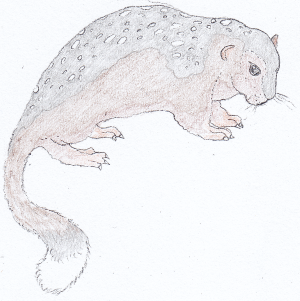Eretvóas
Mlúkrok: Eretvóa /ɛːrɛthvouːa/
Eretvóas1 are small, nocturnal rodents native to Kvaror, the northwestern part of the Múlíat Mountains in southern Dragonía, and were introduced to Vorran Peninsula far to the west by the reptilian Kroks nearly five thousand years ago, where feral populations are now found primarily on Akveb Ridge on the northern part of the peninsula.
Eretvóas1 are small, nocturnal rodents native to Kvaror, the northwestern part of the Múlíat Mountains in southern Dragonía, and were introduced to Vorran Peninsula far to the west by the reptilian Kroks nearly five thousand years ago, where feral populations are now found primarily on Akveb Ridge on the northern part of the peninsula.
Basic Information
Anatomy
Eretvóas are well adapted to life up in mountains and cliffs, where they can squeeze through openings that at first glance would seem impossible for an animal of their size, an ability largely aided by their flexible ribs. Outside Kvaror, the creatures are rare due to competition from other rodents, while on the Vorran Peninsula, their poor swimming skills restrict the eretvóas' spread throughout the lowlands.
Dietary Needs and Habits
Eretvóas are primarily herbivores, eating whatever kind of seeds, flowers and leaves they can find, along with the occasional slow-moving invertebrate.
Additional Information
Uses, Products & Exploitation
Before and during their migration from Kvaror, the Kroks kept eretvóas as a source of food and skins, and divined the future by observing the creatures' behaviour when eating. After they settled on Vorran Peninsula, this practice gradually fell into obscurity as native fauna and flora where domesticated, and nowadays eretvóas are raised for food in less than a dozen villages throughout the region.
Geographic Origin and Distribution
On the Vorran Peninsula, eretvóas are mostly found on the Akveb Ridge to the north, along with smaller populations in the Tvemna Mountains on the western tip and the Vúrakesen Mountains foothills on the other side of the region.
1Original icelandic: eretvóur, singular: eretvóa.
Origin/Ancestry
Southern Dragonía
Body Tint, Colouring and Marking
Most of their body is of varying shades of brown, aside from the back and top of the head, which are black, with irregular white spots adorning the back. The name eretvóa refers to the latter, meaning star-studded back.
Geographic Distribution





Comments